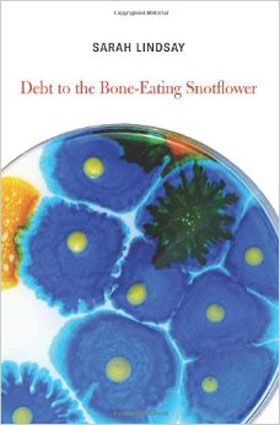Debt to the Bone-Eating Snotflower
by Sarah Lindsay
reviewed by Rachel Trousdale
If the title of Sarah Lindsay’s fourth book, Debt to the Bone-Eating Snotflower, does not instantly make you want to read the book, then it may not be the right book for you. If, on the other hand, you find its peculiarity appealing—if you think, “I know what those words mean, but I don’t know what they add up to”—if you find yourself contemplating how a flower can eat, how snot can flower, and whether you’ve misread the word “debt”—then you will enjoy Lindsay’s intelligent, contemplative collection of scientifically informed poems.
The title, it turns out, is an excellent encapsulation of the book. As the title poem explains, its subject Osedax mucofloris is not a flower at all, but a “tender pink plantlike oceangoing worm” which consumes the whale skeletons with which “every seashore” would otherwise be “barricaded.” Lindsay’s translation of the Latin, “Blushing in the shallows . . . the snotflower strokes a fresh white surface,” turns the bizarre creature into an almost familiar object of affection. While the worm, like the other “worms and cousins of worms,” “has no concept of us,” it makes our lives possible, and the poem asks us to consider both its utility and, to the extent that such a thing is imaginable, its individual subjectivity.
Throughout the collection, this pattern holds: the poems introduce us, gently and in deliberately accessible language, to an array of scientific peculiarities. Lindsay presents us with a cabinet of curiosities full of odd animals, elements of particle physics, and the obsessions of researchers, in the strangeness of which she finds metaphors for human experience.
The world of these poems is not always harmonious. Like many contemporary poets interested in science, Lindsay grapples with global warming and environmental disaster. She is particularly interested in questions of scale, of the individual’s place in a global ecology or a thousand-year time span. In “Only One Known,” which describes the lone specimen of a bird called Sharpe’s rail, she suggests the damning links between scientific inquiry and colonialism. In “Costal Nevada Zoo and Animal Studies Program,” she imagines a postapocalyptic world where researchers try to breed animals “viable under the new conditions,” with indifferent success (the vegetarian lion is eaten by sheep). “Red Fish, Blue Fish” contrasts the slow pace of geological and evolutionary change with the abrupt and catastrophic results of manmade environmental destruction.
More playfully, and thus perhaps more devastatingly, “Whale Feathers” imagines “the whales of our time,” after the mass extinction of the “giants”: “tiny whales and whales the size of chickens” which “perch on white twigs of coral, pipe shrill melodies, / pluck up tube worms from cracks / with one neat turn of the head.” Lindsay once again plays with geological time, invoking the dinosaurs’ mass extinction and their survival by their bird descendants, but also with mythological time and size:
You can ply with cracker crumbs a puff
whose ancestor, Leviathan,
divided the surface with its brow
while its open jaw scraped the ocean floor.
The poem’s equally impossible extremes, Leviathan and the bird-whales, resolve at the end into a tactile image of how thrillingly a small object—animal or poem—can answer our desire to understand the universe:
You may cup a whale briefly in your palm,
stroke its back with one finger,
feel its heart beating like wings, and marvel:
oh the precious, the comprehensible world.
The book is divided into four sections, the first of which is full of human interactions with the natural world: Thai elephants trained to play music, a mummy consumed by mushrooms (which it then consumes), a description of the Curies. The second section focuses on marine biology, with a particular focus on creatures with amorphous shapes like the bone-eating snotflower and especially the octopus. The third is told largely from the point of view of a character named Aunt Lydia, who considers the soul through the medium of quantum entanglement (the phenomenon in which “two particles, once connected, / are bound ever after”). It addresses the problem of loving one’s neighbor in a world full of evil through the example of Komodo dragons, horrible creatures with poisonous bites who follow their doomed prey around for weeks, and returns to the octopus, whose ability to vanish behind a puff of ink becomes a metaphor for the flight of the soul after death: “the true self flew away gracefully, safe, / swiftly, with many arms.” The final section of the book identifies a scale between the evolutionary and the individual, turning to archaeology to describe Neanderthal burials and, in the moving “Deteriorating Inscription,” showing how the loving details of one couple’s life are slowly effaced by time. The book ends on “Last Will,” in which the body of the poet is disassembled in the same way as the couple’s life, its component parts taken and transformed by the various organisms that need them.
With its scrupulous sense of geological time, its attention to unfamiliar animals, and its slight tips of the hat (with a tentacled arm) to predecessors like Elizabeth Bishop and Marianne Moore, Debt to the Bone-Eating Snotflower is a profoundly anti-egocentric book. Lindsay’s meditations on physics and biology are careful and involving, her imagination at once playful and precise, taking us across vast distances without ever losing sight of the particular.
Published on July 1, 2015

